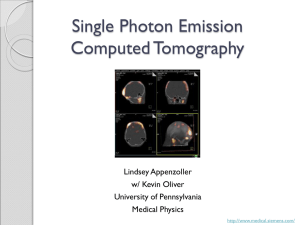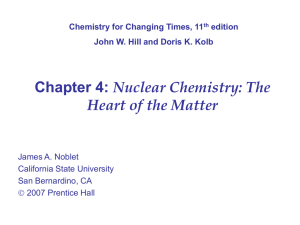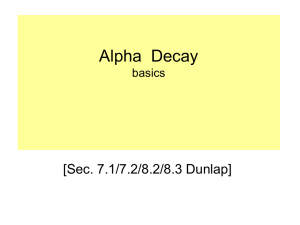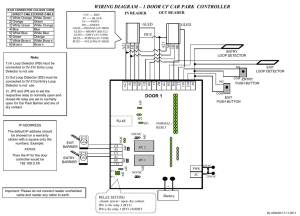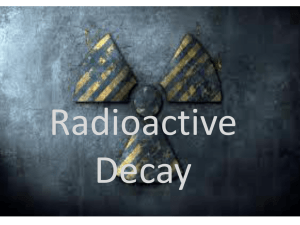Neutrinoless BetaBeta decay
advertisement
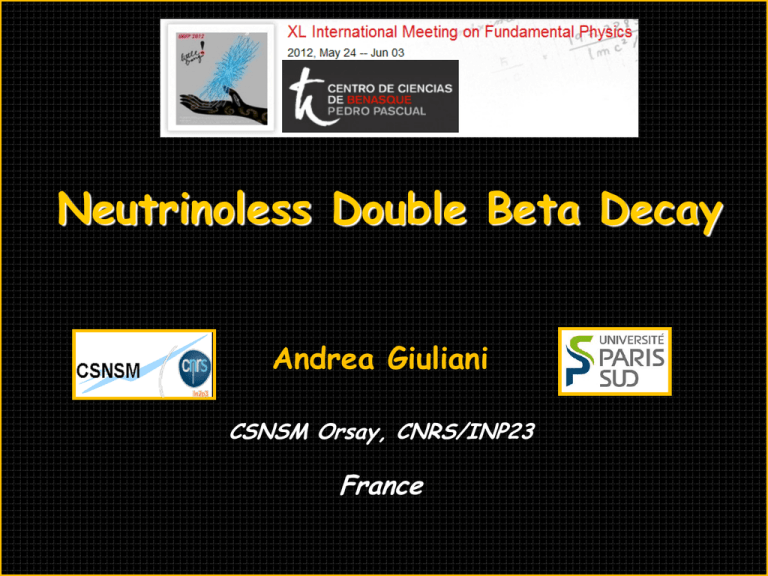
Neutrinoless Double Beta Decay Andrea Giuliani CSNSM Orsay, CNRS/INP23 France Outline Introduction Why Double Beta Decay is important Challenges in front of us Approaches and technologies Some relevant experiments A critical comparison of technologies Conclusions Outline Introduction Why Double Beta Decay is important Challenges in front of us Approaches and technologies Some relevant experiments A critical comparison of technologies Conclusions Decay modes for Double Beta Decay (A,Z) (A,Z+2) + 2e- + 2ne 2n Double Beta Decay allowed by the Standard Model already observed – t ~1018 – 1021 y (A,Z) (A,Z+2) + 2e- neutrinoless Double Beta Decay (0n-DBD) never observed (except a discussed claim) t > 1025 y (A,Z) (A,Z+2) + 2e- Double Beta Decay with Majoron (light neutral boson) never observed – t > 1022 y +c Processes and would imply new physics beyond the Standard Model violation of total lepton number conservation They are very sensitive tests to new physics since the phase space term is much larger for them than for the standard process (in particular for ) interest for 0n-DBD lasts for 70 years ! Goeppert-Meyer proposed the standard process in 1935 Racah proposed the neutrinoless process in 1937 Double Beta Decay and elementary nuclear physics Even-even Weiszaecker’s formula for the binding energy of a nucleus Odd-odd MASS Nuclear mass as a function of Z, with fixed A (even) Odd-odd b Q-value X DBD b+ b+ ECEC Even-even Z How many nuclei in this condition? Q-value [MeV] Limit of the 222Rn induced radiactivity Limit of the g natural radioactivity A Outline Introduction Why Double Beta Decay is important Challenges in front of us Approaches and technologies Some relevant experiments A critical comparison of technologies Conclusions Info from neutrino oscillations oscillations do occur neutrinos are massive given the three n mass eigenvalues M1, M2, M3 we have approximate measurements of two DMij2 (DMij2 Mi2 – Mj2) DM122 ~ (9 meV)2 Solar measurements n3 n2 n1 0.026 |DM232 | ~ (50 meV)2 of the 3 angles which parametrize Ulj ne nm nt Atmospheric elements of the n mixing matrix What oscillations don’t tell us absolute neutrino mass scale neutrino mass hierarchy degeneracy ? direct (M1~M2~M3 ) inverted Future oscillation experiments will have access to this parameter DIRAC or MAJORANA nature of neutrinos nn nn small masses (see-saw) matter-antimatter asymmetry (leptogenesis) Cosmology, single and double b decay Cosmology, single and double b decay measure different combinations of the neutrino mass eigenvalues, constraining the neutrino mass scale In a standard three active neutrino scenario: S 3 S Mi i=1 3 2 |U |2 S M Mb i=1 i ei cosmology simple sum pure kinematical effect 1/2 3 Mbb |Si=1 Mi |Uei|2 eia | i b decay incoherent sum real neutrino double b decay coherent sum virtual neutrino Majorana phases The three constrained parameters can be plot as a function of the lightest neutrino mass Two bands appear in each plot, corresponding to inverted and direct hierarchy S [eV] Present bounds Mbb [eV] Mb [eV] The two bands merge in the degenerate case (the only one presently probed) More in detail: double beta decay and neutrino u d W- d W- u ene ne e- a LH neutrino (L=1) is absorbed at this vertex a RH antineutrino (L=-1) is emitted at this vertex With massless neutrinos, the process is forbidden because neutrino has no correct helicity / lepton number to be absorbed at the second vertex IF neutrinos are massive DIRAC particles: Helicities can be accommodated thanks to the finite mass, BUT Lepton number is rigorously conserved IF neutrinos are massive MAJORANA particles: Helicities can be accommodated thanks to the finite mass, AND Lepton number is not relevant 0n-DBD is forbidden 0n-DBD is allowed Other possible mechanisms (V+A) current <mn>,<l>,<h> SUSY l’111,l’113l’131,….. However, independently of the mechanism, the Schechter-Valle theorem states that Observation of 0n-DBD mn 0 nn even if the light neutrino exchange should not provide the dominant contribution More on the mass mechanism how 0n-DBD is connected to neutrino mixing matrix and masses in case of process induced by light n exchange (mass mechanism) neutrinoless Double Beta Decay rate Phase space Nuclear matrix elements Effective Majorana mass 1/t = G(Q,Z) |Mnucl|2Mbb 2 what the experimentalists try to measure 0.026 parameter containing the physics: what the nuclear theorists Effective Majorana mass try to calculate Mbb = ||Ue1 | 2M1 + eia | Ue2 | 2M2 + eia |Ue3 | 2M3 | 1 2 Mbb [eV] Outline Introduction Why Double Beta Decay is important Challenges in front of us Approaches and technologies Some relevant experiments A critical comparison of technologies Conclusions Three hurdles to leap over Mbb [eV] ~300 meV 100-1000 counts/y/ton Klapdor’s claim 0.5-5 counts/y/ton 20 meV 0.1-1 counts/y/(100 ton) 1 meV The first leap looks easy but one year ago nobody did it… 1990’s 2000’s 2000’s Adapted from A. Faessler et al., Phys. Rev. D79,053001(2009) Ge experimental range (Klapdor) …but something new is appearing at the horizon: Xe is coming KamLAND-ZEN EXO Adapted from A. Faessler et al., Phys. Rev. D79,053001(2009) Background demands Present generation experiments, under commissioning or construction, aim at scrutinizing Klapdor’s claim and possibly attacking the inverted hierarchy region To start to explore the inverted hierarchy region Sensitivity at the level of 1-10 counts / y ton To cover the inverted hierarchy region Sensitivity at the level of 0.1 -1 counts / y ton The order of magnitude of the target bakground is ~ 1 counts / y ton Signal and Background sources Natural radioactivity of materials (source itself, surrounding structures) 100Mo 7.1x1018 136Xe 2.2x1021 Neutrons (in particular muon-induced) Cosmogenic induced activity (long living) 2 n Double Beta Decay d=DE/Q Experimental approaches Two approaches: constraints on detector materials very large masses are possible demonstrated: up to ~ 50 kg proposed: up to ~ 1000 kg e- e- Source Detector (calorimetric technique) scintillation phonon-mediated detection solid-state devices gaseous/lquid detectors with proper choice of the detector, very high energy resolution Ge-diodes bolometers in gaseous/liquid xenon detector, indication of event topology e- detector source e- detector Source Detector scintillation gaseous TPC gaseous drift chamber magnetic field and TOF it is difficult to get large source mass neat reconstruction of event topology several candidates can be studied with the same detector The sensitivity sensitivity F: lifetime corresponding to the minimum detectable number of events over background at a given confidence level b 0 b: specific background coefficient [counts/(keV kg y)] live time source mass b = 0 energy resolution F (MT / bDE)1/2 F MT importance of the nuclide choice (but large uncertainty due to nuclear physics) sensitivity to 1 Mbb Q1/2 |Mnucl| bDE MT 1/4 Choice of the nuclide Transition energy (MeV) 5 Isotopic abundance (%) 40 4 20 3 0 Nuclear Matrix Element 2 48 Ca 76 Ge 82 Se 96 Zr 100 Mo 116 Cd 130 136 Te 150 Xe Nd 48 Ca 76 Ge 82 Se 96 Zr 100 Mo 116 No super-favoured isotope ! Sign of convergence! Cd 130 136 Te 150 Xe Nd But do not forget the phase space! Gon [y-1] Suhonen et al., R0 =1.2 fm & gA = 1.25 10-12 10-13 R0=1.2fm & gA=1.25 10-14 10-15 48Ca 76Ge 82Se 96Zr 100Mo 116Cd 128Te 130Te 136Xe 150Nd 124Sn Outline Introduction Why Double Beta Decay is important Challenges in front of us Approaches and technologies Some relevant experiments A critical comparison of technologies Conclusions Experiment classification criteria ee- Source Detector High energy resolution (<1%) Easy to reject 2n DBD background Easy to approach the ton scale e- detector source e- detector Source Detector Easy to get tracking capability Tracking / topology capability Easy to identify events Class 1 experiments ee- Source Detector High energy resolution (<1%) Easy to reject 2n DBD background Easy to approach the ton scale GERDA – 76Ge Array of enriched Ge diodes operated in liquid argon First phase: 18 Kg; second phase: 40 Kg - LNGS Proved energy resolution: 0.2 % FWHM CUORE – 130Te Array of low temperature natural TeO2 calorimeters operated at 10 mK detector – LNGS – it can take advantage from Cuoricino experience First step: 200eKg (2014) Proved energy resolution: source 0.2 % FWHM MAJORANA –e-76Ge detector Array of enriched Ge diodes operated in conventional Cu cryostats Based on modules; first step (demonstrator): 2x20 KgTracking modules / topology capability Source Detector Proved energy resolution: 0.16 % FWHM Easy to identify events Easy to get tracking LUCIFER – 82Secapability – 116Cd – 100Mo Array of scintillating bolometers operated at 10 mK (ZnSe or ZnMoO4 or CdWO4 ) First step: ~ 10 Kg (2014) – LNGS – essentially R&D project to fully test the principle Proved energy resolution: 0.3 – 0.7 % FWHM Class 2 experiments e- KamLAND-ZEN – 136Xe - e Dissolve Xe gas in KAMLAND liquid scintillator – feasible at 3% wt High energy resolution (<1%) Use a dedicated balloon immersed in the main vessel Source Detector EasyXe to reject DBDphase background Increase number of PM and change scintillator – 300 kg of enriched in the2n first approach the ton scale SNO+Easy – 150to Nd SNO detector filled with Nd-loaded liquid scintillator 0.1% loading with natural Nd → 1000 Kg Nd in 1000 tons scintillators → 56 Kg of isotope Crucial points: Nd enrichment and purity; 150Nd nuclear matrix elements XMASS – 136Xe Multipurpose scintillating liquid Xe detector (Dark Matter, Double Beta Decay, solar neutrinos) Three development stages: 3 Kg (prototype) 1 ton 10 ton DBD option: low background in the MeV region detector Special development with elliptic water tank to shield high energy gamma rays e- an High light yield and collectionsource efficiency energy resolution down to 1.4% control 2n background Target: to cover inverted hierarchy with 10 ton natural or 1 ton enriched e detector CANDLES – 48Ca Tracking / topology capability Array of natural pure (not Eu doped) CaF2 scintillators Source Detector Prove of principle completed (CANDLES I and II) Easy to identify events Proved energy % FWHM (extrapolated from 9.1 % at 662 keV) Easy toresolution: get tracking3.4 capability The good point of this search is the high Q-value of 48Ca: 4.27 MeV out of g (2.6 MeV end point), b (3.3 MeV end point) and a (max 2.5 MeV with quench) Other background cuts come from PSD and space-time correlation for Bi-Po and Bi-Tl Class 3 experiments ee- EXO – High energy resolution (<1%) 136Xe Source Detector Easy to reject 2n DBD background TPC of enriched liquid (first phase) and gaseous (second phase) Xenon Easy to and approach the ton scale Event position topology; in prospect, tagging of Ba single ion (DBD daughter) through optical spectroscopy only 2n DBD background EXO-200: funded, taking data: 200 kg – WIPP facility Further steps: 1-10 ton In parallel with the EXO-200 development, R&D for Ba ion grabbing and tagging COBRA - 116Cd competing candidate – 9 bb isotopes Array of 116Cd enriched CdZnTe of semiconductor detectors at room temperatures Small scale prototype at LNGS Proved energy resolution: 1.9% FWHM e- detector Pixellization can provide tracking capability source e- detector Source Detector Easy to get tracking capability Tracking / topology capability Easy to identify events Class 4 experiment ee- Source Detector High energy resolution (<1%) Easy to reject 2n DBD background Easy to approach the ton scale NEXT – 136Xe High pressure gas TPC Total mass: 100 kg Aims at energy resolution down or below 1% FWHM exploiting electroluminesce in high field region Two prototypes have substantially proved the detection concept and the performance e- detector source e- detector Source Detector Easy to get tracking capability Tracking / topology capability Easy to identify events Class 5 experiments SUPERNEMO - 82Se or 150Nd Modules with source foils, tracking (drift chamber in Geiger mode) and calorimetric (low Z scintillator) sections - Magnetic field e- for charge sign Possible configuration: 20 modules with 5 kg source for each module 100 Kg in Modane extension Energy resolution: 4 % FWHM It can take advantage ofe NEMO3 experience High energy resolution (<1%) BiPo construction to measure the source activity (Canfranc) Detector First step: Source construction of a single module (demonstrator) Easy to reject 2n DBD background 100 82 150 approach scale MOONEasy - toMo or Sethe or tonNd Multilayer plastic scintillators interleaved with source foils + tracking section (PL fibers or MWPC) MOON-1 prototype without tracking section (2006) MOON-2 prototype with tracking section Proved energy resolution: 6.8 % FWHM Final target: collect 5 y x ton DCBA - 150Nd Momentum analyzer for beta particles consisting of source foils inserted in a drift chamber with magnetic field e- detector Realized test prototype DCBA-T2: space resolution ~ 0.5 mm; energy resolution 11% FWHM at 1 MeV source 6 % FWHM at 3 MeV Test prototype DCBA-T3 under construction: aims at improved energy resolution thanks to higher e- detector magnetic field (2kG) and higher space resolution Tracking / topology capability Final target:Source 10 modules with 84 m2 source foil for module (126 through 330 Kg total mass) Detector Easy to identify events Easy to get tracking capability Outline Introduction Why Double Beta Decay is important Challenges in front of us Approaches and technologies Some relevant experiments A critical comparison of technologies Conclusions CUORE Class 1 Technique/location: natural 988 TeO2 bolometers at 10-15 mK– LNGS (Italy) evolution of Cuoricino Source: TeO2 – 741 kg with natural tellurium - 9.5x1026 nuclides of 130Te Sensitivity: 41 – 95 meV (5 years) – approach/attack inverted hierarchy region Timeline: first CUORE tower in 2012 (CUORE-0) data taking with full apparatus in 2015 Detector in the custom fridge Structure of the detector CUORE-0 Class 1 First CUORE tower, just assembled (April 2012) – waiting to be cooled down in former Cuoricino cryostat (LNGS) CUORE background Class 1 Cuoricino experience + dedicated tests in the CUORE R&D phase clearly shows the most critical background component Cuoricino background model Background budget Dominant contribution: energy-degraded alphas from Cu surface facing detectors It will contribute at a level of 2.5x10-2 counts/(keV kg y) If removed, 1 order of magnitude lower background would be possible! LUCIFER and scintillating bolometers Class 1 Technique/location: scintillating enriched bolometers at 10 mK – LNGS (Italy) Source: options: 82Se, 100Mo, 116Cd – realistic amount: 7x1025 82Se nuclides Sensitivity: ~100 meV in 5 years but difficult to state now (uncertainty on enrichment and purification processes) Timeline: R&D set-up with significant mass: 2014 Real light and heat signals acquired with a CdWO4 scintillating bolometer Two lines (1) 82Se LUCIFER and scintillating bolometers Class 1 – ZnSe crystals - funded by ERC advanced grants – LNGS 10-15 kg enriched isotope (2) 100Mo – ZnMoO4 crystals – approved for funding in France (ANR LUMINEU) 1 kg enriched isotope LUCIFER and scintillating bolometers Class 1 Example of alpha/beta separation in large ZnSe crystal (~400 g) - LNGS Decay time in the light signal vs Light Light vs Heat alphas betas Example of alpha/beta separation in prototype ZnMoO4 bolometer (Orsay) Pulse shape discrimination in the heat signal MC estimation of the background: 4x10-4 counts/(keV kg y) Phys. Lett. B 710, 318 (2012) GERDA Class 1 Technique/location: bare enriched Ge diodes in liquid argon – LNGS (Italy) Source: Ge - 14.6 kg – 76Ge enriched at 86% - 9.7x1025 nuclides (phase 1) Sensitivity: it can scrutinize Klapdor’s claim in ~1 year data taking Timeline: GERDA phase-I is taking data in a physics run GERDA-phase 1 - status Class 1 After some excess background in the debugging phase with normal crystals due to a higher than expected contamination of 42Ar, now with enriched crystals the background is close to the expectation: 1.7x 10-2 counts/(keV kg y) Two detectors out of nine exhibit anomalous leakage current and have been eliminated Typical calibration energy spectra with energy resolution at 2615 keV (typically ~5 keV FWHM) GERDA – new detectors BEGe detectors are p-type HPGe’s with a n+ contact covering the whole outer surface and a small p+ contact located on the bottom. Main properties: enhanced Pulse Shape Discrimination properties, which can be exploited for background reduction purposes Single site event bb event Multi site event g event Class 1 GERDA - prospects Class 1 NEXT Class 4 Technique/location: High pressure (10 bar) enriched Xe TPC – Canfranc (Spain) Source: 136Xe enriched at 90% - 89 kg corresponding to 3.9x1026 nuclides Sensitivity: better than 100 meV in 5 years Timeline: prototypes are working – commissioning of full detector in 2014 Energy: both electroluminescence and direct scintillation are recorded in the photosensor plane behind the transparent cathode Tracking: exploit electroluminescence light generated at the anode and recorded in the photosensor plane behind it Energy resolution is crucial in Xe 136Xe Q-value: 2458 keV Highest energy line of 214Bi: 2447 keV Double beta decay event (MC) arXiv:1202.0721 Class 4 NEXT – energy resolution in prototype (1) NEXT-DBDM (LBNL) : short drift, high solid angle, one plane of PMTs (SiPM plane under way) - 137Cs calibration ~0.53 % at DBD energy (but in central region) Class 4 NEXT – energy resolution in prototype (2) NEXT-DEMO: long drift, “small” solid angle, two plane of PMTs (SiPM plane starting soon) Energy resolution in all fiducial volume: 1.1 % FWHM in DBD region (after applying corrections taking into account the zone of the interaction) Class 4 NEXT – tracking in prototype (2) NEXT-DEMO: track of an electron produced by a 662 keV gamma NEXT – background Class 4 Shielding Estimation od the background generated by high energy gammas (214Bi line at 2447 keV and 208Tl line at 2615 keV) reaching the active volume by applying 3 selection cuts: single track confined within the active volume energy falls in the region of interest, defined as 0.5 FWHM around Q the spatial pattern of energy deposition corresponding to that of a DBD track (blobs in both ends). Estimated background: 8x10-4 counts/(keV kgisotope y) KamLAND-ZEN Class 2 Technique/location: enriched Xenon dissolved in liquid scintillator - Kamioka Source: 136Xe enriched at 91% - 300 kg (129 kg fiducial 5.2x1026 nuclides) Sensitivity: limit obtained: 300 – 600 meV Timeline: presently in pause Totally different approach wrt NEXT Moderate energy resolution No tracking/topology but impact point (fiducial volume) Coincidence cuts arXiv:1201.4664v2 KamLAND-ZEN – results Class 2 For the second time (see EXO) 2n DBD of 136Xe is measured, resulting ~5 times faster than a previous limit T2n1/2 = 2.38 ± 0.02(stat) ± 0.14(syst) × 1021 The background in the region of interest is almost two orders of magnitude higher than expected: monochromatic contributions of unclear origin The low energy resolution (~9% FWHM) doesn’t help in the comprehension of the background T0n1/2 > 5.7 × 1024 (90% c.l.) 77.6 days X 129 kg (fiducial volume) EXO Class 3 Technique/location: phase 1: liquid enriched Xe TPC – WIPP (New Mexico, US) Source: Xe - 200 kg – 136Xe enriched at 80% - 7.1x1026 nuclides Sensitivity: limit obtained 140 – 380 meV Timeline: phase 1 data taking – phase 2: R&D (Ba tagging) Spatial resolution offered by the charge and light readout allows to distinguish single site (SS) events – signal – from multisite (MS) events – background. EXO Detail of the field cage Class 3 Detail of the LAAPD read-out plane Detail of the wires EXO - results For the first time 2n DBD of the KamLAND-ZEN result 136Xe Class 3 is measured, in excellent agreement with T2n1/2 = 2.11 ± 0.04(stat) ± 0.21(syst) × 1021 Multisite events Single site events PRL 107, 212501 (2011) EXO - results Class 3 In the 0n DBD of 136Xe the limit obtained by EXO is excellent and starts to attack seriously the Klapdor claim Zoom in the region of DBD 32 kg y Multisite events Single site events (potential signal) Background: 1.5x10-3 counts/(keV kg y) arXiv:1205.5608v1 EXO - results Class 3 Energy resolution: improved thanks to charge-light correlation (~3.9% FWHM) EXO and Klapdor Class 3 Outline Introduction Why Double Beta Decay is important Challenges in front of us Approaches and technologies Some relevant experiments A critical comparison of technologies Conclusions The path to the limit DE Take specific background coefficient [counts/(keV kg y)] b Multiply them [counts/(kg y)] DExb Multiply by detector mass, live time → bkg counts DExbxMxT Calculate limit Nlim Invert, multiply by number of atoms and live time T x Nat/ Nlim Take energy resolution [keV] Figure of Merit for the technology Scalability of the technology b [counts/(keVkg(isotope) y)] The experiments from the DExb point of view 1 Cuoricino anticipated by MC 10-1 10-2 HM GERDA-1 MAJORANA 10-3 GERDA-2 10-4 10-5 done/running/proved CUORE SNO+ EXO-200 LUCIFER Or upgrade of bolometers NEXT Super NEMO KamLAND -ZEN NEMO-3 KamLAND-ZEN 1 100 10 DE FWHM [keV] 1000 A dimension is missing… Scalability of the technique Excellent for Xe-based techniques Reasonable for Ge/bolometers Bad for external source approach Outline Introduction Why Double Beta Decay is important Challenges in front of us Approaches and technologies Some relevant experiments A critical comparison of technologies Conclusions Exciting times for neutrino masses: degeneracy will be deeply probed S [eV] Future bounds PLANCK + larger surveys Mbb [eV] Mb [eV] discovery potential in case of inverted hierarchy Present generation


